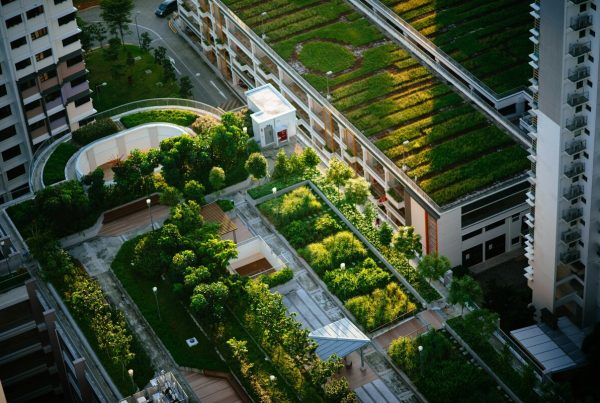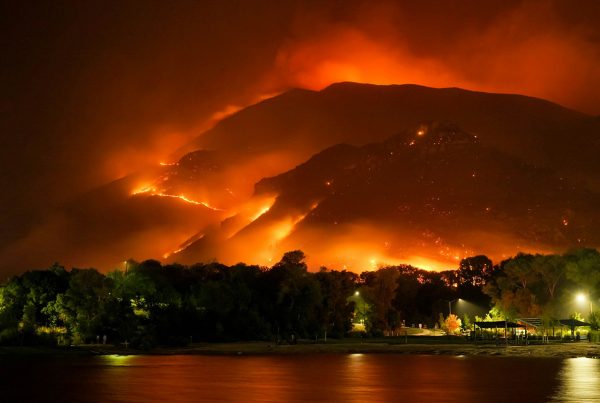So here we are again at the end of the month with our story roundup. We’ve compiled 8 of the most popular and interesting stories around the Web, from ingeniously insulating 3D-printed bricks to wooden buildings to a statewide ban of mentioning global warming in Florida.
1. Algae Overgrowth Can Be Harnessed as Biofuel
New research presented at the American Chemical Society looks into the possibility of harnessing harmful algae bloom into biofuel. The technique involves controlled growth of algae using 3D printed materials, allowing it flourish closer to the source but not letting it spread downstream. They can be then harvested and used as biofuel.
Some algae produce toxins that poison fishes and other marine life, which can get passed on to humans who eat them. Non-toxic algae on the other hand can clog fish gills and choke them.
2. Photo Book Metamorpolis Captures Chongqing’s Rapid Urbanization
An upcoming photo book, Metamorpolis, by French-Polish lensman Tim Franco captures the images of the city of Chongqing in China. This relatively obscure megacity is in a state of rapid urban development, steadily abandoning its rural roots. In 2010, the Chinese government encouraged migration to urbanize Chongqing’s rural population, with more than 1,300 people moving into the city daily.

Traditional farmer caught in the rapid transition of Chongqing from rural to urban (Image from ArchDaily)
Metamorpolis documents the transition of Chongqing from rural to urban, with stark images of long-time residents clinging to their traditional way of life are juxtaposed against the urbanized landscape. In the process of growth, the city has had to sacrifice farmlands, ancient and historical buildings, and other cultural landmarks.
3. Vienna Plans a Wooden Building
Come 2016, architects in Vienna plan to build a high-rise building out of wood, with the impressive height of 276 feet. Dubbed the HoHo Project, the tower will be 76{e3829ec1db02d54faaf9fa2de0d48db26af01d7a7944a63c3b26976124791cab} wood (particularly cross-laminated timber or CLT). Compared to concrete, wood saves as much as 2,800 tonnes of CO2 emissions.
Caroline Palfy, the developer behind the project says, “I think it is important everyone now in 2014 thinks in different ways. We have wood, which is a perfect construction material for building,” she said. “It was used 200 years ago and it was perfect then and is perfect now.”
Wood as a building material became a hot topic in a 2013 TED Talk by Michael Green, especially considering the large carbon footprint of concrete.
4. At 57 Stories, World’s Tallest Prefab Is Built in China
Broad Sustainable Building (BSB), specializing in prefab building technology, has just completed a 57-storey apartment building in Changsa, China.
The prefab building rose at a remarkable height of three floors per day. Factors such as insulation, cooling, heating, and power were all given due attention, and as such BSB claims the building is 80{e3829ec1db02d54faaf9fa2de0d48db26af01d7a7944a63c3b26976124791cab} more efficient than regular buildings. A 3-stage air purification system addresses the air pollution issue that’s rampant in China. BSB also claims that 15,000 trucks full of concrete were saved from their prefab method.
BSB is also the company behind Sky City, set to be the tallest skyscraper in the world. Construction began in 2013 but halted on and off by the Chinese government due to permission and specification issues.
5. Terms Such as “Climate Change” and “Global Warming” Are Banned in Florida
Former employees at the Department of Environmental Protection in Florida have divulged that since 2011 they have been prohibited from using the terms “climate change”, “global warming”, “sustainability”, etc. in any official communications, emails, or reports. No official written policy exists, just a verbal communication cascaded to everyone. Apparently, this started in 2011, after Governor Rick Scott took office.
Kristina Trotta, a former DEP employee, reveals, “We were instructed by our regional administrator that we were no longer allowed to use the terms ‘global warming’ or ‘climate change’ or even ‘sea-level rise’. Sea-level rise was to be referred to as ‘nuisance flooding.”
Florida, ironically, is among the top states in the US most vulnerable to climate change effects such as sea rise (or nuisance flooding) and tropical cyclones. The ban naturally has dampened the impact of the department’s educational materials, annual reports, training programs, etc. that would have otherwise spurred necessary policy changes.
6. How Divestment from Fossil Fuels Can Do the Planet a Lot of Good
The Guardian is holding a campaign to urge the Gates Foundation and the Wellcome Trust to divest their endowments from fossil fuels. Their logic is simple: progressive institutions like those two should never have anything to do with the undeniably major cause of global warming. Scientific studies have unanimously concluded that slowing down coal consumption is crucial to ensure our species survives, but as the Guardian points out, most of the time, politics gets in the way of science.
According to reports, Wellcome Trust had £564m invested in Shell, BP, Schlumberger, Rio Tinto and BHP Billiton, while over $1bn was invested by the Gates Foundation on fossil fuel companies. If these two influential foundations divested, it would go a long way to slowing down the consequences of global warming, even if only by a marginal degree. The more important thing is that the divestments would encourage other investors to steer clear of coal energy, and turn to cleaner and more renewable energy instead.
Campaigns for divestment started out in Europe back in 2013, with Fossil Free UK. Glasgow University became the first university in Europe to opt out of fossil fuels, inspiring other colleges and universities worldwide.
7. 3D-Printed Cool Brick
3-D printing company Emerging Objects has developed an ingenious brick that has cooling effects. Made of ceramic, the 3D-printed brick features a lattice design that efficiently absorbs water like a sponge. The trapped water would then readily evaporate as air passes through the micropores, and thus the cooling effect.
The cool brick was inspired by the Muscatese evaporative cooling windows wherein windows are outfitted with a wooden screen called mashrabiya, while a porous water-filled ceramic vessel is nestled inside, slowly evaporating a cool breeze as the day wears on.
8. How Skyscrapers Are Causing Thundersnow in Our Cities
Thunder and lightning during a snowstorm are an unusual weather occurrence, but they’re becoming more common these days. A 2009 research cites that our cities’ skyscrapers are partly to blame for them.
Typically, thundersnows happen when a mass of cold air collects on top of warm air, with moist air closer to the ground. The imbalance of air temperature creates unstable air columns that form into charged clouds. Skyscrapers likewise easily build up a charge along with the surrounding charged clouds.
The research revealed “that >93{e3829ec1db02d54faaf9fa2de0d48db26af01d7a7944a63c3b26976124791cab} of all lightning in the snow band was likely or possibly associated with self-initiated upward lightning (SIUL) events from a variety of tall, and some not so tall, structures.”












